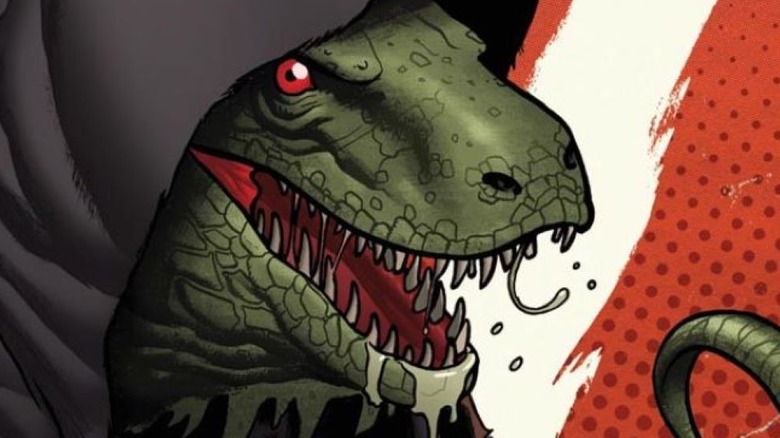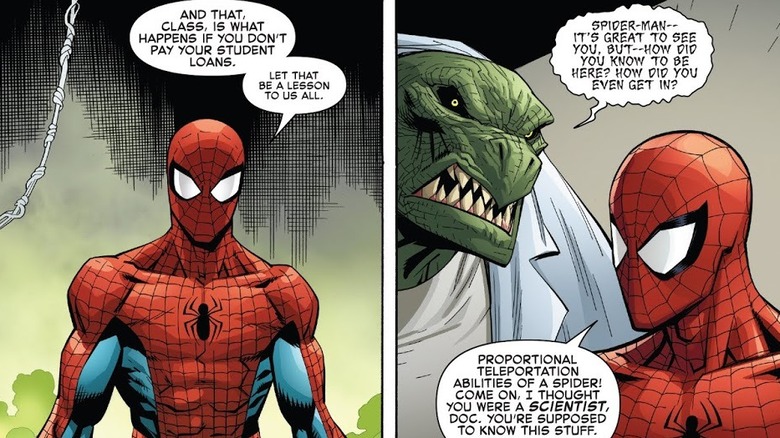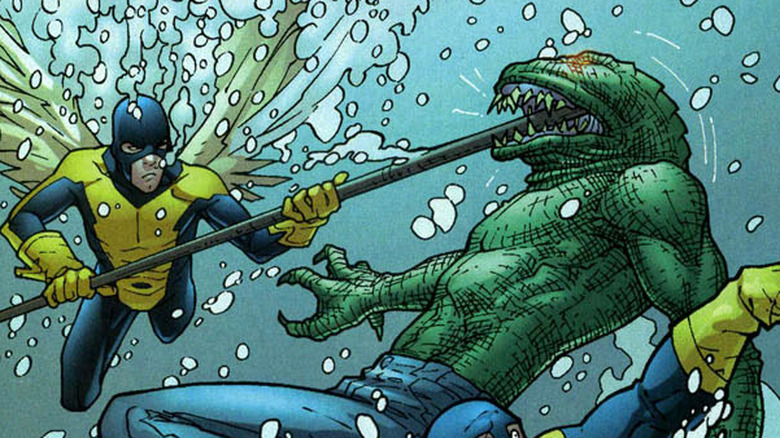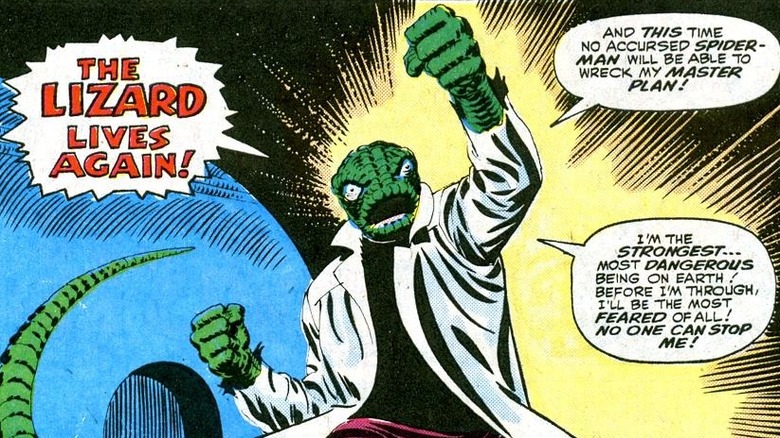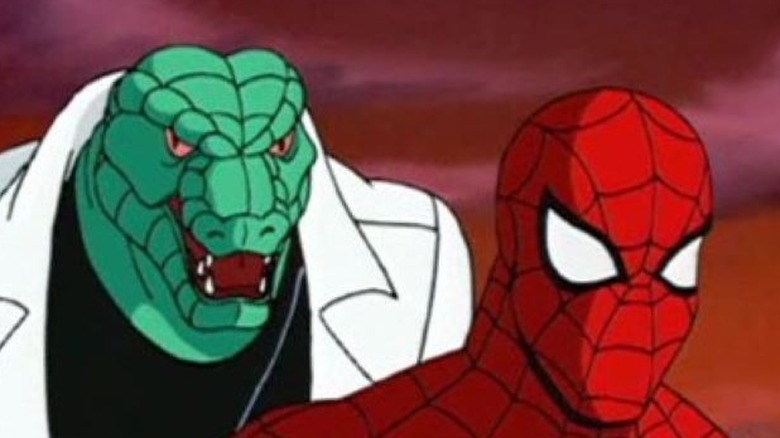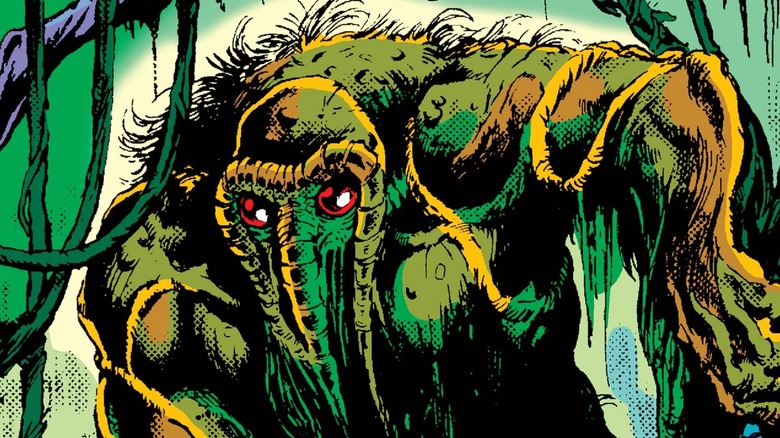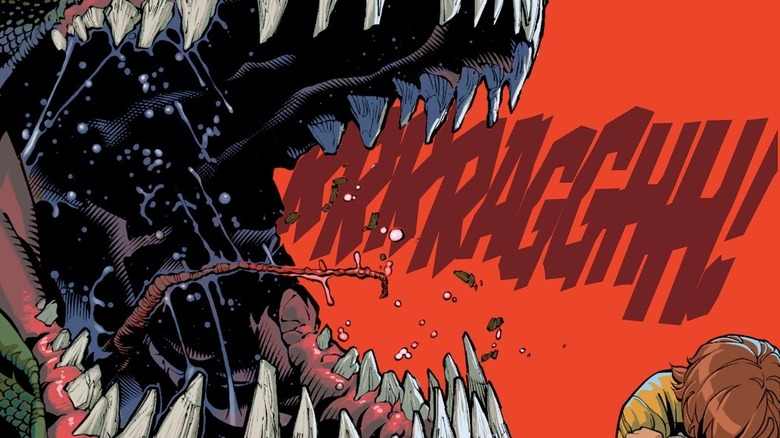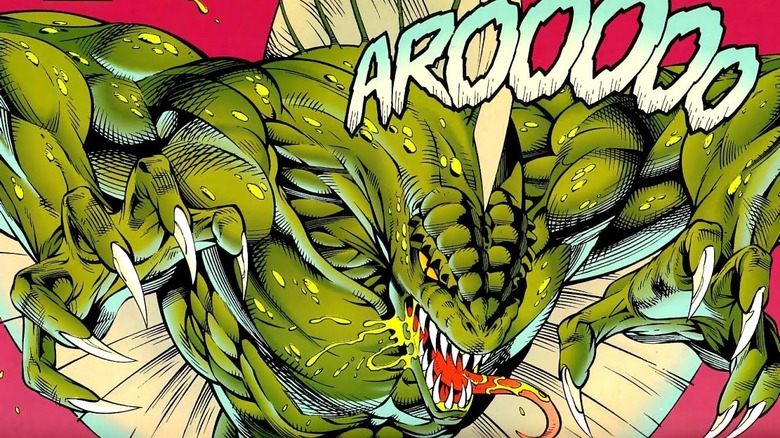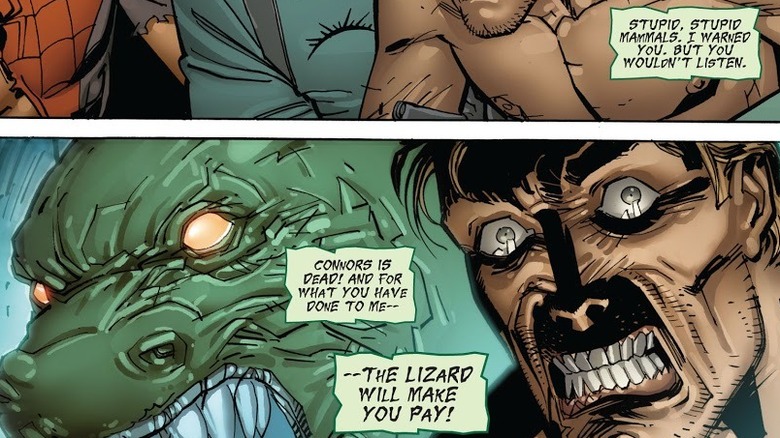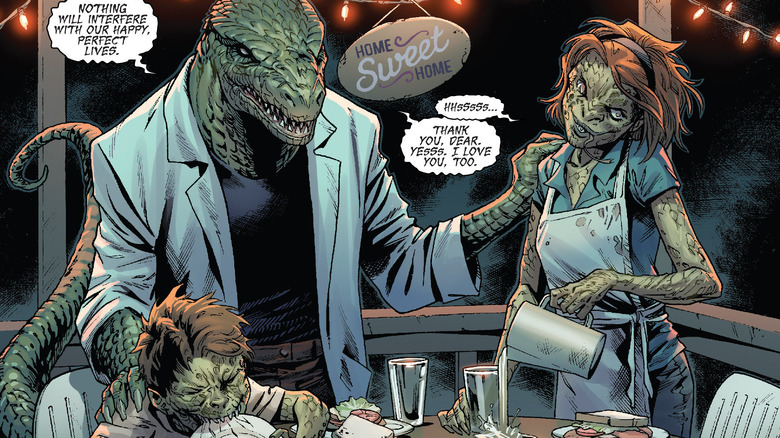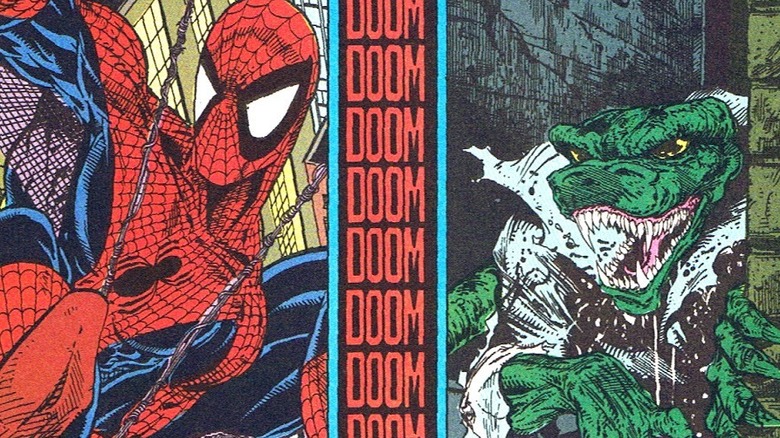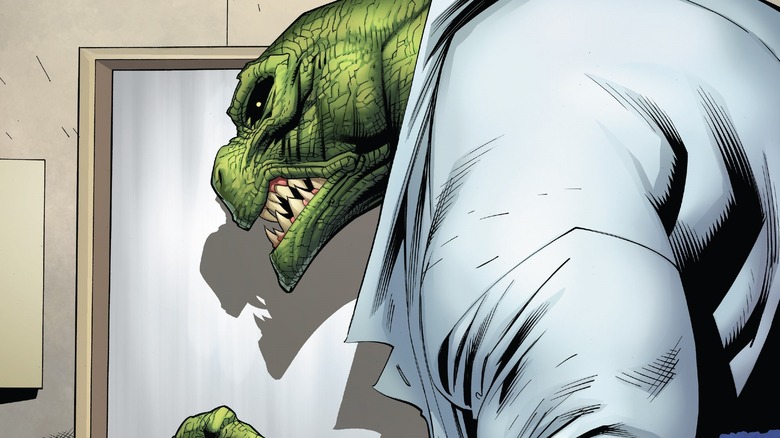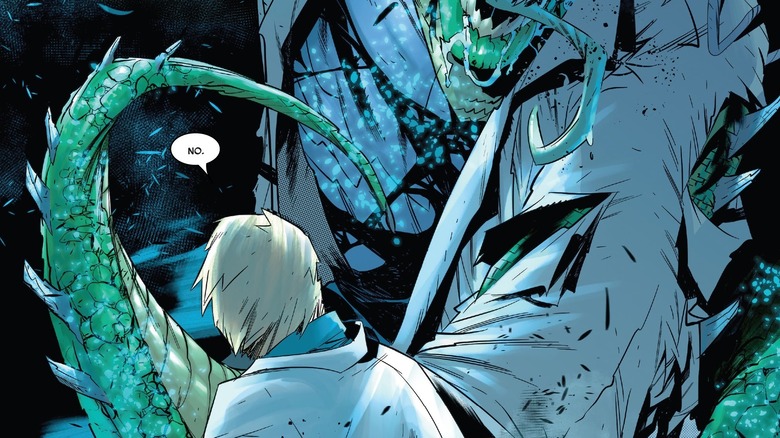The Untold Truth Of Marvel's Lizard
Imagine that you're a scientist, one of the pioneers in your field. One day, an experiment goes wrong, giving you a "gift" you can't control: The ability to transform into a strong, dangerous, green-skinned monster. If you're a fan of superheroes or comic books in general, that scenario probably sounds familiar to you. After all, that's basically how Bruce Banner got turned into the Incredible Hulk. Interestingly enough, another Marvel character suffered the same fate — and instead of an eventual Avengers membership, it earned him both the enmity and friendship of a different superhero.
With his reptilian visage, sharp claws, scaly skin, and prehensile tail, the Lizard is one of Spider-Man's most easily recognizable foes. Since his first appearance in 1963's "Amazing Spider-Man" #6, Dr. Curt Connors has both aided and bedeviled the wall-crawler, with the latter usually happening when he changes into his dangerous alter-ego. The Lizard's imposing character design, tragic story, and unique role in Spider-Man's life have made him a classic member of the superhero's rogues gallery AND supporting cast. And whenever they meet — whether it happens in a swamp, a university laboratory, the sewers of New York, or even a planet in a distant galaxy — their clashes frequently bring out the best (and the worst) in both characters. This is the untold truth of Marvel's Lizard.
The Lizard is Spider-Man's ultimate frenemy
Dr. Connors became the Lizard as a result of his quest to regrow his right arm, which he lost during his years of military service. A brilliant surgeon and biochemist, he studied lizards in an attempt to find a solution, fascinated with the reptiles' amazing regenerative abilities. He succeeded after ingesting an experimental serum laced with lizard DNA; however, his joy was short-lived, as it kicked off decades of unwanted physical transformations, mental torture, and emotional trauma.
Across his entire publication history, Spider-Man has developed a unique dynamic with the Lizard that none of his other villains have ever truly achieved. The webslinger often saves Dr. Connors' life by either helping him transform back to being human or defeating his monstrous alter-ego before it causes further harm. In return, the good doctor has lent invaluable assistance to the hero on many crucial occasions. One example was in "Amazing Spider-Man" Vol. 1 #33: Dr. Connors develops a cure for Peter's ailing Aunt May, who was suffering from a radioactive blood illness after Peter gave her some of his own blood to save her life.
Another noteworthy instance was in "Amazing Spider-Man" Vol. 1 #102, when a six-armed Spider-Man (who mutated after an attempt to rid himself of his powers goes awry) and the Lizard team up to defeat the vampire Morbius. With some plasma they obtain from the blood-sucking villain, Dr. Connors comes up with a serum that rids Peter of his extra appendages.
The Lizard fought the X-Men early on (and was Professor X's college friend)
Despite being closely associated with Spider-Man, the Lizard has occasionally tangled with other superheroes as well. A 2006 comic featuring some of the X-Men's untold early adventures revealed that the team's classic "first appearance" roster faced off against the reptilian villain — and that their mentor, Professor Charles Xavier, actually has an unexpected connection to him.
In issue 2 of the "X-Men: First Class" limited series, Professor X plans a well-earned vacation for his students (Cyclops, Iceman, Jean Grey, Beast, and Angel) in Florida. Before they reach their intended destination, however, Xavier proposes that they stop by the house of a brilliant friend from his undergraduate days: none other than Dr. Curt Connors. As luck would have it, Dr. Connors turns out to be in the middle of one of his Lizard transformation phases, prompting Professor X to send out the team to find Dr. Connors and cure his condition.
Many, many years later, the adult versions of Spider-Man and the X-Men team up to investigate a string of kidnappings in New York, in a three-part story running in the pages of "X-Men" Vol. 3 (#8-10). Together, they found the culprits: With assistance from an evil alternate reality version of Beast, the Lizard has been capturing New Yorkers and turning them into lizardfolk using a special machine. The superheroes manage to put a stop to this scheme, but the Lizard is able to slip away.
The Lizard: An alternate persona, or just Connors all along?
The case of Dr. Connors has traditionally been presented as a Jekyll-and-Hyde situation: Whenever the Lizard comes out to play, it's not Dr. Connors in the driver's seat, but his evil "reptilian" side. In other words, the Lizard acts independently of Dr. Connors, making the tortured biochemist as much of a victim of his transformations as the people the Lizard puts in harm's way. However, a story in 2004 presented an alternative take that contradicted established continuity so much, it has been ignored by nearly every major Lizard story after it.
Issue 11 of the rebooted "Spectacular Spider-Man" title shows Dr. Curt Connors struggling to gain custody of his son, Billy. (In a separate miniseries titled "Spider-Man: Quality of Life," Dr. Connors' wife Martha dies of cancer following exposure to some dangerous chemicals, triggering the scientist's tragic descent into fully embracing the Lizard persona.) A lost research grant triggers a reptilian rampage that seriously injures Dr. Connors' rival scientist. Spider-Man investigates, helping Dr. Connors find refuge along the way, until Dr. Connors himself reveals the horrifying truth: For quite some time, he has been in full control of his Lizard episodes, and has only been pretending otherwise. At the end of the three-part story, Dr. Connors realizes that he has become a danger to his own son, and willingly lets himself get imprisoned. Sadly, this revelation sabotaged years of Dr. Connors' character development, and was quickly swept under the rug.
An unlikely ally in the Secret Wars
According to former Marvel Comics editor-in-chief Jim Shooter, Mattel approached him in the early '80s with a proposal to publish a special "event" to accompany a toyline. Called "Secret Wars," the event featured some of Marvel's most popular heroes and villains, along with a few oddballs thrown into the mix. One of the spotlighted characters was the Lizard, who had a fascinating journey (albeit largely irrelevant to the overarching story) throughout the 12-issue maxi-series.
In "Secret Wars," a cosmic being, the Beyonder, transports Earth's mightiest heroes and villains to a makeshift planet called Battleworld, pitting the two sides against each other to better understand the concepts of good and evil. Unlike the rest of the heroes and villains stuck on Battleworld, however, the Lizard shows disinterest in participating in the conflict; after the first battle, he follows his reptilian instincts and immediately runs off to a swamp. Despite being picked for the villains' side, the Lizard doesn't do anything particularly evil here; he even dies at the hands the Enchantress after vainly trying to avenge a colleague's death. Dr. Connors surprisingly turns up alive at the end, free from the Lizard. He and Spider-Man return to Earth safely, after which he takes a sample of Spider-Man's new black costume to study. In the adaptation for the '90s Spider-Man cartoon series, the Lizard (with Dr. Connors' mind) immediately starts out on the heroes roster.
An infamous Marvel monster unknowingly helped create the Lizard
Due to the interconnected nature of Marvel's books, characters from different corners of the universe would often end up having strange and unexpected connections. Some even had unknowing roles in each others' origin stories. Such was the case of two of the publishing house's most interesting and tragic monsters: the Lizard and the Man-Thing.
A 2010 issue of "Web of Spider-Man" Vol. 2 gives a brief glimpse of how Dr. Curt Connors lost his arm in the war while serving as a medic. Ending up in the hospital after trying to save a booby-trapped soldier, Dr. Connors meets Dr. Ted Sallis, a fellow biochemist working on reconstituting the Super-Soldier serum that created Captain America. The two scientists become fast friends, exchanging notes on cellular regeneration. Dr. Sallis and Dr. Connors eventually lose contact after the former moves to the Everglades, but not before Dr. Sallis points Dr. Connors in the direction of lizard DNA for his experiments. One night, while escaping AIM agents who want to steal his work on the serum, Dr. Sallis makes his way to a swamp and self-injects the only vial of the serum (which was now a cocktail of his and Dr. Connors' research). Instead of dying, Sallis turns into a mindless, shambling mound called the Man-Thing, later revealed to be a being of partially mystical origins.
The Lizard killed his own son
After his transformation into the Lizard, Dr. Connors' relationship with his young son Billy became tremendously strained. For many years, Dr. Connors struggles to keep his family together as he seeks a cure for his condition, and his son has no idea what his father is going through. At one point, Dr. Connors attempts to eliminate the Lizard permanently by obtaining a DNA sample from Billy, who is unaware that his father and the Lizard are one and the same, and using it to formulate a cure.
However, a major turning point in their relationship takes place in "Amazing Spider-Man" Vol. 1 #632 – a tragic mistake that will haunt the scientist for the rest of his life. When the Lizard persona rears its ugly reptilian head once more as the Shed, it realizes that to prevent Dr. Connors from ever returning, the monster must commit a crime so terrible, the human side would never want to come back. The Shed proceeds to hunt down, kill, and partially consume Billy, and even gains control of the cold-blooded parts of New Yorkers' brains to unleash their reptilian sides. With much effort (and after nearly getting beaten to death by a Lizard-controlled mob), Spider-Man manages to tap into whatever's left of Dr. Connors' mind inside the Lizard, making the creature retreat to the sewers and put a stop to the city-wide chaos.
The Lizard accidentally created three other reptilian villains
Dr. Connors' attempts to rid himself of his Lizard side became the catalyst for not one, not two, but three monstrous Marvel villains to come into existence: One was a savage mirror of himself, one was a mutated reptile, and one turned himself into a dinosaur-man.
After the apparent death of Dr. Connors in Lizard form, a new one emerged some time later. While many initially thought that it was Dr. Connors, there was something different about this Lizard: It sported fins, wore no clothes, and displayed no semblance of human intelligence. "Spectacular Spider-Man" Vol. 1 #238 revealed that this new Lizard was originally a severed lizard tail injected with Dr. Connors' new formula; in a battle with the original Lizard, this mindless version loses its life. This harkens back to a similar lab mishap over 200 issues earlier: Dr. Connors' lab tests accidentally mutate an iguana and imbue it with his memories, turning it into the supervillain called Iguana.
And then there's Dr. Vincent Stegron, who injected himself with Dr. Connors' formula mixed with dinosaur DNA in "Marvel Team-Up" Vol. 1 #19 and became Stegron, the Dinosaur Man. In addition to his enhanced strength, prehensile tail, and Stegosaurus-inspired appearance, Stegron has the ability to control dinosaurs mentally, as well as manipulate the reptilian side of human brains (in a manner similar to Dr. Connors' "Shed" persona).
Right mind, wrong body (and vice versa)
A never-ending struggle between his two distinct personalities exists in Dr. Connors' body, but the distinction has almost always been clear: Dr. Connors' mammalian brain obviously controls his human body, while the reptilian side of him gets unleashed along with his physical Lizard form. However, there have been times when the wrong brain ends up in control.
In "Amazing Spider-Man" Vol. 1 #688, Spider-Man and Morbius the Living Vampire attempt to cure the Lizard permanently, using a serum with DNA samples from Dr. Connors' deceased son Billy. Unbeknownst to them, the serum has the unintended effect of transforming only Dr. Connors' physical body, while leaving his Lizard brain in control. It takes the combined effort of Spider-Man, Morbius, and the scientists at Horizon Labs to stop the Lizard-piloted Dr. Connors from creating a formula that could enable him to transform again.
However, his brief time in Dr. Connors' body makes the Lizard brain consider staying human forever, even after successfully transforming into the Lizard again. By the end of the conflict in "Amazing Spider-Man" Vol. 1 #691, the Lizard has been subdued and thrown back into the Raft, but not before a horrible secret is revealed to the reader: Dr. Connors' brain is now secretly dominating the Lizard's body, and is intentionally staying incarcerated because he wishes to pay for his crimes.
The Lizard turned his wife and son into lizard-people
Dr. Connors has always prioritized the well-being of his wife and son, and was devastated when he lost both of them. However, the emergence of a new version of a classic Spider-Man villain gave him the chance to rebuild his family again, albeit in a different, twisted way.
During the "Dead No More: The Clone Conspiracy" storyline that ran in different Spider-titles from 2016 to 2017, the Lizard is revealed to be working with a brand-new Jackal: Peter Parker's clone Ben Reilly, the hero formerly known as Scarlet Spider, who had been driven to the brink of insanity after getting killed and resurrected 27 times as part of a cloning experiment. To get Dr. Connors on his side, the Jackal has resurrected both Martha and Billy Connors; Dr. Connors agrees to help the Jackal repower a revived Electro for his master plan.
Unfortunately, most of the Jackal's clones perish at the end of the story because of the Carrion virus, which accelerates their decay. Dr. Connors is able to save his family from this fate by injecting them with the Lizard formula; since then, they are living with him in a secret home under the sewers, attempting to carry on with their lives.
A Lizard story greatly contributed to the '90s comics crash
With the arrival of the 1990s, the Lizard got a much-needed shot in the arm by virtue of a mega-hit comic book story, written and illustrated by none other than then-rising superstar Todd McFarlane.
Prior to the launch of McFarlane's adjectiveless "Spider-Man" book, he had already redefined Spider-Man for a new generation of readers with his striking interpretation of the character; his success on "Amazing Spider-Man" led to Marvel greenlighting his very own title. McFarlane reportedly chose the Lizard as the antagonist for his five-part story, "Torment," because no other classic rogue was available: "After some discussion, we finally realized that the Lizard had not been drafted yet and, though he might not be Spidey's best villain, he is still considered one of the classics."
The book set sales records at the time: With all of its variant covers combined, issue #1 sold a staggering 2.35 million copies (via The Hollywood Reporter). However, this also pretty much kickstarted the speculator market, in which opportunistic market watchers bought multiple copies of a comic in anticipation of its value rising. By the time they'd realized the flaw in their logic, the damage had already been done: By the mid-1990s, comics publishers were experiencing massive sales drops, and Marvel filed for bankruptcy. (On the bright side, the '90s comics crash did pave the way for the superhero movie explosion of the 2000s, but that's a story for another time.)
Dr. Curt Connors teaches classes in Lizard form
Dr. Connors' inability to keep his Lizard side permanently under control has been a staple of his character throughout his entire comics history. However, the 2018 relaunch of the "Amazing Spider-Man" title brought a massive change to the character's status quo. With the help of the scientists at the fictional Empire State University, Dr. Connors accomplished the seemingly unthinkable: He could teach classes while transformed as the Lizard.
Despite his track record as a supervillain, Dr. Connors was granted a second chance by ESU to revitalize his academic career. This came in the form of a powerful inhibitor chip that Dr. Connors co-developed with ESU's scientists; in a way, it works similar to the one that the cinematic version of Doctor Octopus wore in the 2004 film "Spider-Man 2."
In "Amazing Spider-Man" Vol. 5 #2, Dr. Connors explains to a visibly shocked Peter Parker how the inhibitor chip works. The chip comes in an indestructible Adamantium casing, and is embedded behind his neck; it gives him the ability to transform from reptile to human and vice versa, but also instantly paralyzes him once it detects that he's about to attack someone as the Lizard.
Curt Connors and the Lizard: Split for good?
No matter how many times Dr. Connors tries to leave his villainous past as the Lizard behind, it seems like he'll never be able to fully escape it. However, a fresh attempt at dragging him back into the fight may have permanently freed him from the Lizard's shadow.
As part of the "Sinister War" storyline, Doctor Octopus goes around recruiting members of his newly reformed Sinister Six. After having brought Sandman, Kraven, and Electro into the fold, Doc Ock literally comes to Dr. Connors' door. Initially, Dr. Connors thinks that the four are out to capture him; however, it's revealed that they simply want to activate the isotope-genome accelerator, a device that Dr. Connors had been working on, in order to separate him from his Lizard persona. The plan succeeds, and man and reptile become two different entities; the villains leave with the newly split Lizard in tow, as Dr. Connors lies, injured but alive, in his destroyed lab. Peter Parker arrives at the scene and takes Dr. Connors back to his family. Only time can tell how long this will last — and if Dr. Connors is truly free from the Lizard's scaly grip.
